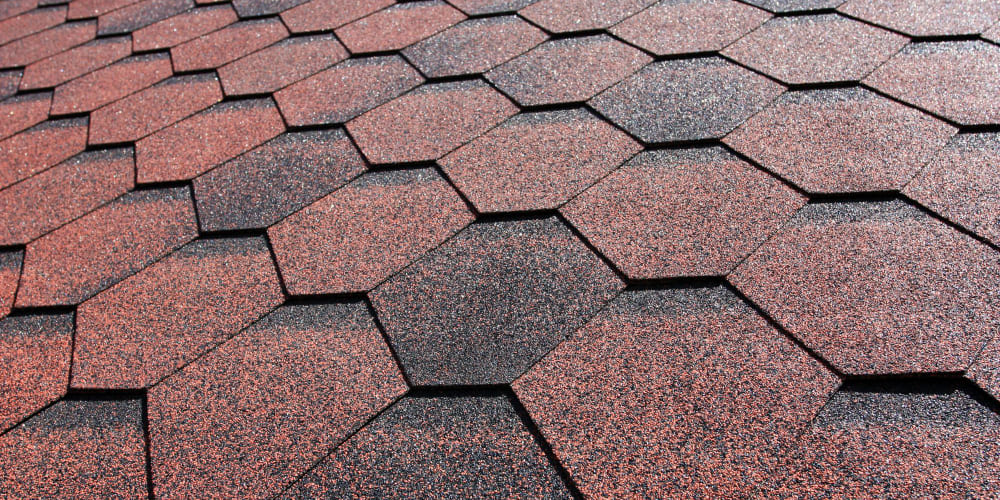Overall, asphalt shingle underlayment prevents leaks and improves the lifespan of your roof, and it is an important integral roof component.
Roof underlayment is a water-resistant and waterproof protective layer that contractors install beneath roofing material to support the shingles and enhance the roof’s performance. Once the shingles get damaged, the underlayment protects your home’s interior.
Therefore, let’s explore the different roof underlayment types, compare their features and help you determine what is the best roof underlayment for your home.
Types of Roof Underlayment
From traditional roof underlayment with excellent waterproofing capabilities to modern options, suitable for hot regions, knowing about underlayment varieties allows you to pick the best one and enhance your roofing system performance.
Asphalt-Saturated Felt
Asphalt-saturated felt or tar paper is a traditional roofing material, used for its affordability and straightforward installation. The felt consists of fiberglass or organic mat saturated with asphalt.
Such construction makes it great against moisture and various weather conditions.
Asphalt felt remains popular because of its excellent features:
- Affordability
- Simple installation
- Compatibility with different roofing systems
- It prevents leaks and prolongs the roof’s lifespan
Compared to synthetic options, asphalt shingles shows its drawbacks:
- Less durable than synthetic options,
- Heavier
- More prone to tearing.
Synthetic Underlayment
Contractors recommend synthetic underlayment over asphalt-saturated felt, because of the superior strength. The synthetic underlayment is made from polyethylene or polypropylene, and it is lightweight and offers excellent moisture protection.
Moreover, synthetic underlayment is often used with modern roofing systems, to provide long-lasting and reliable protection. However, synthetic underlayment is more expensive than asphalt-saturated felt.
Benefits:
- Lightweight
- Tear-resistant
- Excellent UV protection compared to asphalt-saturated felt
- Superior water resistance
Rubberized Asphalt
If your budget allows you, consider getting rubberized asphalt for your roof underlayment. It is a premium option with self-adhesive backing which fits excellently around fasteners. This type of underlayment ensures superior water protection, so it is a choice number one for homeowners in areas with heavy rains and ice.
Moreover, because of the self-sealing features, rubberized asphalt provides extra robust protection. It is an excellent choice for steep-slope roofs and regions with lots of rain, ice, and overall moisture. You can install it with asphalt shingles, metal, tile, and slate roofs for best performance.
Advantages:
- Outstanding water and ice protection
- Self-sealing around nails,
- Reliable protection even in high-moisture areas.
Disadvantages:
- High price tag
- The complex installation requires professional roofers
Factors to Consider When Choosing Underlayment
The best roofing underlayment materials for your roof depend on several factors, including installation, typical weather in your area, roof design, etc.
Climate
If you live in a high-moisture area or cold climate, rubberized asphalt is your best choice for superior waterproofing and leak prevention in case of heavy rains and snow.
Synthetic underlayment offers excellent heat resistance and performs well when exposed to prolonged sunlight. In addition, synthetic underlayment is a great choice for windy areas because it is tear-resistant.
Asphalt-saturated felt is budget-friendly and the best option for moderate climates.
Roof Slope
Roof slope impacts the traction requirements and water runoff and determines the complexity of underlayment installation:
- Steep slope – The best option is synthetic underlayment due to enhanced traction, low weight, and tear-resistance
- Low-slope – Because of the need for superior water protection, rubberized asphalt is the best choice.
- Moderate slope – Asphalt-saturated felt ensures a good balance of protection, performance, and price
Budget
The price for different types of roof underlayment varies greatly. For example, rubberized asphalt and synthetic underlayment cost significantly more money, but they will last longer and perform better in all conditions than affordable asphalt-saturated felt.
Installation Ease
If you are ready for a DIY roof underlayment installation project, your best roof underlayment is the type that is the simplest to install – synthetic underlayment. It comes in rolls that are easy to handle and tear-resistant so you can easily mark and cut the areas you need.
Building Codes and Manufacturer Requirements
Lastly, make sure to consult local authorities and check if specific requirements are regarding asphalt roof underlayment. Moreover, some shingles manufacturers recommend you install their products with certain underlayment types for the best possible performance and warranty purposes.
Benefits of High-Quality Underlayment
If you pick your roof underlayment poorly, you risk severe issues with your roof and costly repairs. Not only will your roof last shorter, but you risk severe water leakage and structural problems with your roof.
Enhanced Moisture Protection
The roof is the outer barrier against weather, but it becomes a solid defense only if you choose the best underlayment for shingle roof. The underlayment is essential against wind-driven rain and ice dams.
Premium materials, such as rubberized asphalt, are reliable even in extreme weather conditions. Because they prevent water from penetrating your home interior, your initial investment will pay off through less frequent repairs caused by water damage.
Improved Durability
Roofing underlayment comparison based on the impact on roof durability shows significant differences between cheaper and premium roof underlayments. For comparison, rubberized underlayment can make roofs last up to seven decades, with consistent performance and less frequent repairs.
A cheaper underlayment, especially if it isn’t installed properly or not suitable for your roof type and slope angle, makes the roof age faster, causes water buildup, and various other issues.
Additional Insulation
The best underlayment for shingles improves the overall energy efficiency of your home, lowering your energy bills and maintaining a consistent indoor temperature.
Underlayment works as an additional insulation layer which reduces the heat retention on the attic. In addition, if the underlayment has reflective properties, it will ensure your attic cools faster.
Lastly, roof underlayment seals gaps and overlaps, so there are fewer air leaks and heat loss, which is especially helpful in winter months.
Fire Resistance
Synthetic and rubberized asphalt underlayment is recommended by contractors because of their excellent fire-resistant properties. That way, if you invest in high-quality underlayment, you’ll improve your home safety, by preventing the spread of fire.
Delaying the fire from spreading, you ensure your home occupants will have additional time to evacuate and call for help.
Popular Brands and Products
The range of available roof underlayment for shingles shows that everyone favors robust construction and strength which has exceptional waterproofing capabilities.
GAF Deck-Armor™
GAF Deck-Armor™ is a special type of synthetic underlayment with enhanced properties. It reduces the level of moisture inside the underlayment, so it keeps the entire roofing system secure against moisture.
The underlayment is breathable and remains dry even in high-moisture areas and wind-driven rain. Most roofing professionals prefer GAF Deck-Armor™ for various roofing types and designs.
Owens Corning® ProArmor™
If tear resistance is an important factor for roof underlayment, like is the case with complex roof designs and steep slopes, contractors opt for Owens Corning® ProArmor roof underlayment.
It is another synthetic type that is praised for its exceptional durability and ability to perform evenly in dry and hot areas, as well as windy and rainy climates. Moreover, the Owens Corning® ProArmor is slip-resistant, which simplifies installation and makes it a great choice for DIYers.
Grace Ice & Water Shield®
Grace Ice & Water Shield® is one of the top choices for homeowners looking for top-notch water protection. The underlayment creates a waterproof, perfect seal around nails, so it is unparalleled against ice das and wind-driven rain.
Grace Ice & Water Shield® is self-adhering and relatively simple to install. Because of its great performance in extreme weather, roofers install it in areas prone to hurricanes, earthquakes, and other high-risk areas.
Tyvek® Protec™
Tyvek® Protec™ is durable and UV-resistant synthetic roof underlayment. If your roof is exposed to UV rays for the most part of the day, Tyvek® Protec™ will maintain its integrity in the years to come.
Other features include slip-resistant features, non-woven structure, simple installation, and compatibility with different roofing systems.
Conclusion
Underlayment for asphalt shingles is a must-have roof deck component to improve durability and roof performance against weather. You have several options – asphalt-saturated felt, rubberized asphalt and synthetic underlayment.
Synthetic underlayment may have the widest application and great value for the money, and rubberized asphalt ensures robust protection. Asphalt-saturated felt is a reasonable option for mild slopes and mild climates.
If you still wonder what’s the best underlayment for roofing and your home, consult us and we’ll help determine the best solution.
FAQ
Can roof underlayment void the warranty of my roof?
Yes, when choosing underlayment for your roof consider manufacturer specifications and specific installation requirements to ensure the warranty remains valid. The requirements address compatibility with different types to ensure you install the best roof underlayment for optimal performance and durability.
Can roof underlayment lower my energy bills?
Yes, the best underlayment for shingles and other roof types works as an extra insulation layer and can help keep the indoor temperature consistent. Because it prevents increased attic temperatures and prevents heat loss, you will have to use your cooling and heating system less.
What roof underlayment types are considered environmentally friendly?
Underlayments made from recycled materials, such as rubber are considered environmentally friendly. Moreover, because synthetic underlayments have longer lifespans they require less frequent replacing, which results in less waste.






